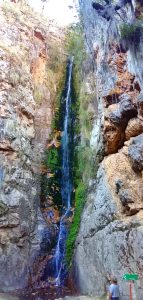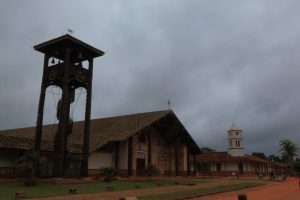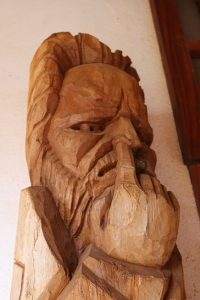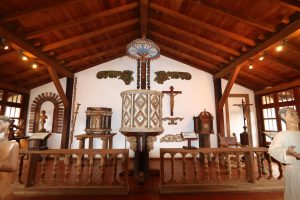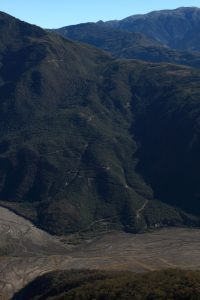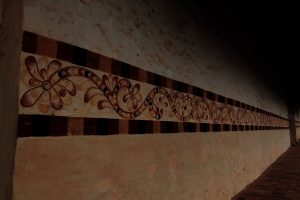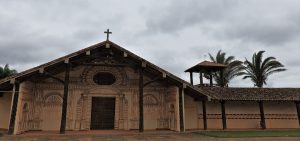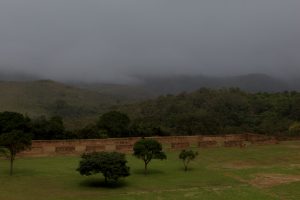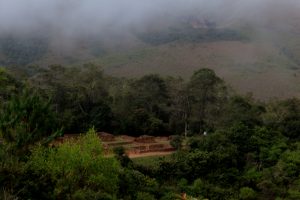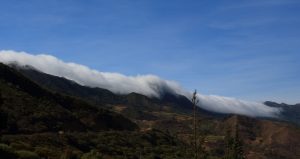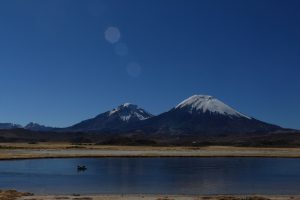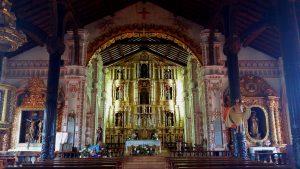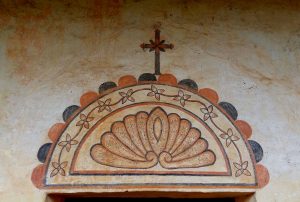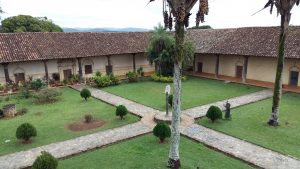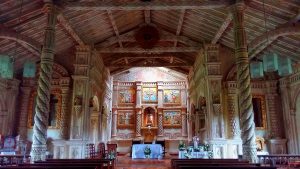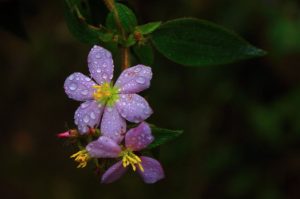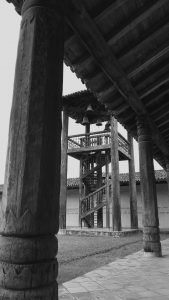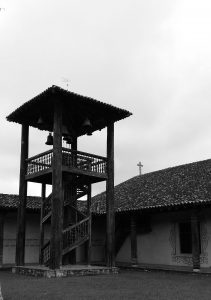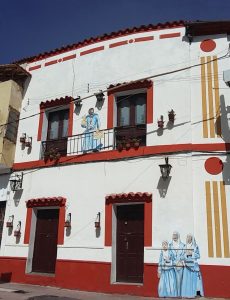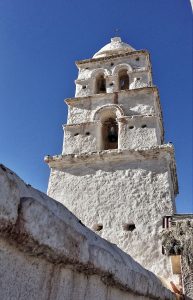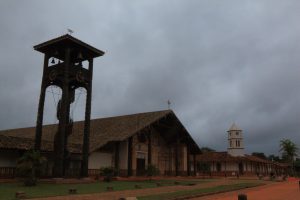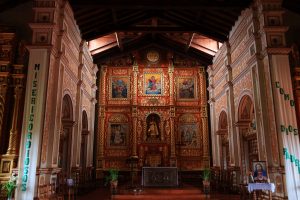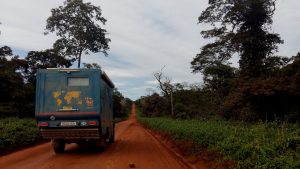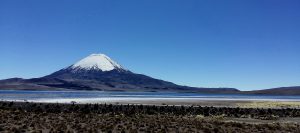We never learn our lesson! Crossing a border during the sacred ‘eating of the lunch’ ritual – don’t do it folks! These people take their lunch-break seriously! You only end up with a lot of waiting and not necessarily in an orderly line. But in our excitement at arriving in a new country, we have forgotten this simple principle again! We approach the Bolivian border at around 13:00 hrs and realise ‘the wait’ is on!
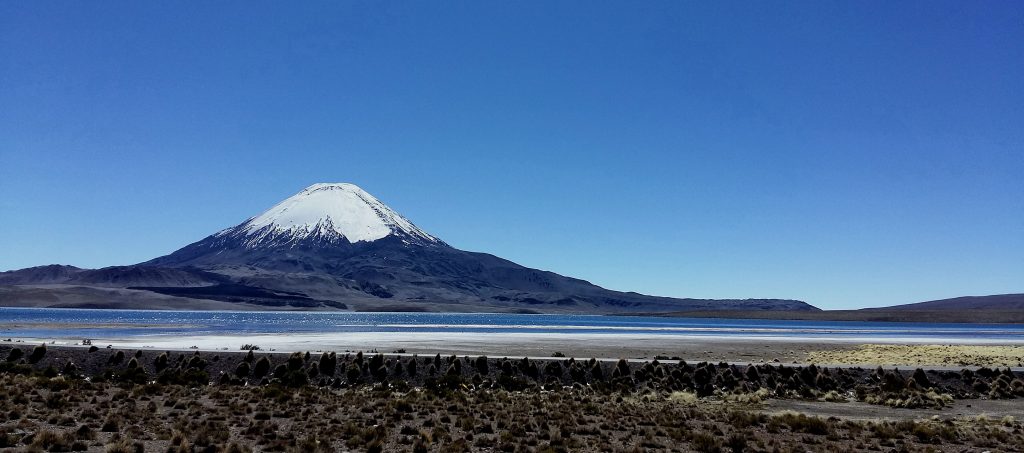
Intro to Bolivia! Great view at the border
First impressions
The scene was reminiscent of a central African border crossing. Chaotic. Scores of trucks parked randomly all over the place blocking each other’s egress and lorry drivers sitting around in groups cooking lunch on little stoves outside the run-down buildings. There are no signs on the doors or counters and disinterested officials dismissively direct us from office to office with a general wave of the hand in an indistinct direction. But it’s all part of the overlanding fun and with the assistance of a couple of helpful lorry drivers, we finally find the building to obtain Cuthbert’s temporary import permit. It’s a fabulous view of lakes and volcanos as we drive into a new country, a new adventure for Cuthbert!
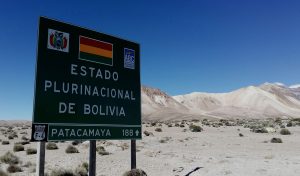 After a few hours driving on a cross-country rough road east-wards, we looked for somewhere to park-up for the night, but we encountered a small ‘snaggette’…. Although we have the same series of mapping for Bolivia as we had for Argentina and Chile (the German ‘Reise Know-How World Mapping Project’) there is significantly less detail on the Bolivia map. The lack of map detail had led us to imagine that we were heading into a remote and un-populated part of the country. Instead, we found countless huts, houses, farms and tiny hamlets scattered all over the place! These are all constructed with adobe mud bricks and roughly thatched rooves such that they blend very successfully into the landscape. Every time we turned down a side-track to try to find a spot to park-up, we found ourselves in someone’s front yard!
After a few hours driving on a cross-country rough road east-wards, we looked for somewhere to park-up for the night, but we encountered a small ‘snaggette’…. Although we have the same series of mapping for Bolivia as we had for Argentina and Chile (the German ‘Reise Know-How World Mapping Project’) there is significantly less detail on the Bolivia map. The lack of map detail had led us to imagine that we were heading into a remote and un-populated part of the country. Instead, we found countless huts, houses, farms and tiny hamlets scattered all over the place! These are all constructed with adobe mud bricks and roughly thatched rooves such that they blend very successfully into the landscape. Every time we turned down a side-track to try to find a spot to park-up, we found ourselves in someone’s front yard!
Eventually some lorry drivers advised us to park-up in a village square and we had a peaceful first night in Bolivia. We were going to celebrate this new chapter of our journey with a wee-drinkie but then reminded ourselves that we are at over 4,000m/13,100ft. From experience we have learned that at this altitude, even one glass of wine can dehydrate and lead to really bad night’s sleep, so we stuck to the fruit juice for now!
River route
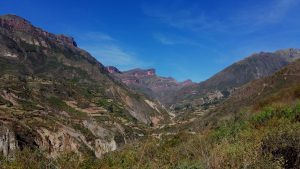 Next morning we continued our back-road exploration of rural Bolivia on a track that turned out to be far, far longer, narrower and rougher than we expected from the map. Had we looked more closely at the topographical detail on one of our GPS maps, we would probably have noticed how much the track clings to the winding mountainside, dropping periodically into and out of the deep and steep-sided valleys. For two whole days we crawled around extremely narrow tracks with sheer drops of over 1,000m off the edge of the road. Still, at least the Bolivian highway authority has put good road-side safety barriers in place… NOT! Our speed rarely exceeded 20kmph and at the end of a very tiring and slightly nervous ‘Day 1’, we came to a washed away bridge over a wide river. There were track-marks of vehicles driving into the river on our side, so they presumably must exit somewhere at the other side; but by this time it was almost dark and we were exhausted. We decided to park-up for the night and tackle the river-crossing in the morning.
Next morning we continued our back-road exploration of rural Bolivia on a track that turned out to be far, far longer, narrower and rougher than we expected from the map. Had we looked more closely at the topographical detail on one of our GPS maps, we would probably have noticed how much the track clings to the winding mountainside, dropping periodically into and out of the deep and steep-sided valleys. For two whole days we crawled around extremely narrow tracks with sheer drops of over 1,000m off the edge of the road. Still, at least the Bolivian highway authority has put good road-side safety barriers in place… NOT! Our speed rarely exceeded 20kmph and at the end of a very tiring and slightly nervous ‘Day 1’, we came to a washed away bridge over a wide river. There were track-marks of vehicles driving into the river on our side, so they presumably must exit somewhere at the other side; but by this time it was almost dark and we were exhausted. We decided to park-up for the night and tackle the river-crossing in the morning.
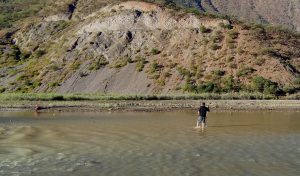
Walking the river
In the bright early-morning sun the river looked lovely, but we couldn’t see how deep it was or where the track exited the water. We also couldn’t see whether the riverbed was a firm rock/pebble base for Cuthbert to drive on, or whether it was soft silty mud that he would sink into. The bank on the other side looked a bit swampy which made us nervous with our 6 tonne Cuthbert. We donned our wellies and attempted to wade across, but it was a bit too deep for our wellies. There was nothing else to do… we had to brave the icy water with Crocs (the shoes, not the toothy reptile!) and shorts. Well, I say ‘we’… Marcus gallantly stepped-up to the challenge. The river was only just over his knees but it was icy, icy cold! He found a firm route across the riverbed and out onto the other side. Once the route through was clear, it was all a bit of a ‘non-event’ and the marvellous Cuthbert tacked the river-crossing with ease.
Great! So we’re on our way again, but we still had another full day of 20kph precarious mountain driving and it was dusk before we finally pulled into the town of Cochabamba. By now we had descended to around 2,500m altitude and felt that the bottle of Marlbec that we opened on arrival was well deserved!
Cochabamba Blocks
Cochabamba is one of Bolivia’s few major cities and we spent a few days there exploring. It’s not exactly the charm-centre of Bolivia, but it is clean and had some lovely town plazas with well restored architecture. On our first morning in Cochabamba we had a slightly surreal experience – sitting with a nice cup of tea in Cuthbert, politely minding our own beeswax, when the unmistakable, orchestral sound of Elgar’s ‘Land of Hope and Glory’ came wafting in with the breeze! Blimey… where are we? The Royal Albert Hall??? It transpired that we were near a local school rehearsing for a graduation, but we are still none the wiser as to why they chose this particularly British piece of music for their ceremony.
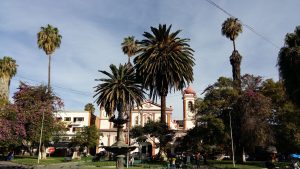
Cochabamba
One piece of news that reached us in Cochabamba was that, unbeknown to us, we were unwittingly ‘stuck’ in the town. How so? Well… it seems that the good old Bolivian workers are having one of their periodic ‘discussions’ with ‘El Presidente’ Evo Morales. They don’t get to actually speak to him personally in quite the way they’d like, so they blockade the country’s main inter-city road routes (this isn’t as difficult as it sounds, there aren’t many of these) and prevent traffic from moving around the country. Evo, in theory, should then feel the pressure to respond to their demands. The workers apparently do this quite frequently and tourists have, on several occasions in recent years, been stranded in cities unable to get to the airport to catch flights home. The blockades are generally peaceful provided nobody tries to breach them. So we are ‘stuck’ here, but it’s a pleasant enough place and it doesn’t concern us unduly. Friday morning we see by the magic of inter-webbery that a deal has been struck, at least for now. The blockades are lifted with the apparent caveat that if Evo doesn’t come up with the goods in the next 15 days (although we’re not entirely sure what these ‘goods’ are), the blockades will be back in place.
Tyre Story
Now let’s divert a little from the travel stuff to talk about Cuthbert’s shoes. He favours a Michelin XZL 225/100 R16. These are excellent off-road tyres but are unfortunately difficult to find in South America. Even specialist Michelin dealers don’t keep them in stock. Chile it seems, is one of the few countries that doesn’t require sellers to have a special licence to import and supply them, but that doesn’t necessarily make them easy to come by in Chile!
At the moment there is no urgency at all; we have around 20,000km still to go on the existing set. But we need to plan ahead a bit… there is a long lead-time for the procurement. Our ‘Plan A’ hope before we left Chile was to order some via the Michelin dealer in Arica (far north Chile) but that, as t.v. detectives say, turned out to be a false lead!
So we now revert to ‘Plan B’. When we were in Santiago we found a supplier that can import them for us. It’s inconvenient because we really don’t want to return that far south to collect them, but we have placed the order by email, ready to collect later in the year. Delivery time will now be 4-6 months rather than the 3-4 months originally quoted, but we can live with that. There are two silver linings to this cloud: first, they are around 40-50% cheaper here than in Europe; and secondly, the dealer has a branch in northern Chile which will save us (there and back) over 2,000 km of driving to collect when they arrive. Marvellous! As I think The A-Team’s Hannibal Smith once said… “I love it when a plan comes together!” 🙂
Seasonally Eastwards
The more we travel in South America the more we appreciate the wisdom of a bit of ‘tactically pre-emptive route selection’. High mountain passes are not best tackled in the snowy season; jungles and swamps are not recommended destinations in the rainy season, etc. etc. etc. With such a huge continent and long distances, it’s difficult to always be in the right place in the right season, but cutting a long story short, we’re now heading east to do some jungley/swampy bits with the benefit of the dry season. Our target destination, just over the border into Brazil, is a massive wetland area known as The Pantanal, famed for its wildlife and in particular, jaguar spotting.
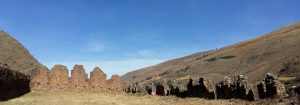
Inca? Or pre-Inca?
En-route eastwards we stop off to see some Inca ruins at Incallajta and some pre-Inca ruins at Samaipata. The scenery is beautiful all the way across the country and we are enjoying the journey across Bolivia so far, but the roads are in need of a little TLC! Incallajta is the less than impressive site of the most easterly extent of the Inca empire. It’s (just about) worth a stop if you’re passing, but we don’t think Peru’s Machu Picchu will be concerned about any competition! Further down the road (actually, it’s much further, and a rough road) is the small town and fortification ruins of Samaipata. This is a chilled-out little town with a great market and the fort ruins are an infinitely more worthwhile visiting than Incallajta.
Continuing east again, our route dropped off the high plateau and we finally found ourselves on the eastern side of the Andes – the ‘jungle side’. We’re still some way south of the Amazon, but the environment here is very different to the western side; there are palm trees and it’s green! There’s a reason for this leafy-greeniness… it’s called ‘rain’, and there seems to be plenty of it right now. UK readers will be familiar with this ‘rain’ concept, but we can’t recall the last time we saw any. The concerning thing is, that if the aforementioned ‘benefit of the dry season’ has not yet arrived, it may not be the best time to head over to Brazil’s Pantanal. Hmmm… bravely (or stupidly?) we decide to push-on ever eastwards… in the rain.
Half a Jesuit Mission Circuit
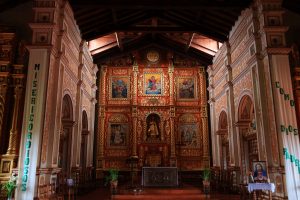 The city of Santa Cruz is the major hub of eastern Bolivia, but it doesn’t have much else going for it. We spend a quick but fun night there meeting up with some South African overlanders and then move on east again to the ‘Jesuit Mission Circuit’. This is a long circle-route in eastern Bolivia passing seven Jesuit Missions. The Missions were originally designed and built by the Swiss Priest Martin Schmidt in the 1700s, but they fell into serious disrepair in the late 1800s and were then largely forgotten until they were restored in the 1970/80s by German architect Hans Roth. They were then brought to global attention by Bob de Niro and Jezza Irons in the 1986 Hollywood movie ‘The Mission’ and they are said to be very much worth a visit.
The city of Santa Cruz is the major hub of eastern Bolivia, but it doesn’t have much else going for it. We spend a quick but fun night there meeting up with some South African overlanders and then move on east again to the ‘Jesuit Mission Circuit’. This is a long circle-route in eastern Bolivia passing seven Jesuit Missions. The Missions were originally designed and built by the Swiss Priest Martin Schmidt in the 1700s, but they fell into serious disrepair in the late 1800s and were then largely forgotten until they were restored in the 1970/80s by German architect Hans Roth. They were then brought to global attention by Bob de Niro and Jezza Irons in the 1986 Hollywood movie ‘The Mission’ and they are said to be very much worth a visit.
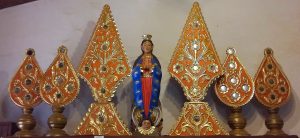 Before setting off for the Jesuit Missions, we had the challenge of buying some fuel. Doesn’t sound much of a ‘challenge’ does it? But you need to know that fuel at the pump is heavily subsidised for the Bolivian citizen. Of course ‘El Presidente’ Evo doesn’t intend this subsidy to benefit foreign vehicles, so we should be charged the higher ‘Gringo Rate’. This much we knew before we came to Bolivia, but after trying a couple of fuel stations, we learn that only one chain of fuel stations – the government owned ‘YPFB’ – is authorised to sell to foreigners. Some of the other non-YPFB stations may be persuaded to sell to foreigners at the local subsidised price if you walk in with jerry-cans (the CCTV then doesn’t see the foreign registered vehicle), but there are two reasons we are reluctant to do this at the moment: first, we need a lot of litres for Cuthbert, which will be quite a lot of jerry-can hassle. Secondly, we have heard that at exit borders, officials are now asking for receipts to show where you bought fuel, so it could be helpful to have at least one of these receipts to show if asked. Anyway, after a few tries we fill Cuthbert at a YPFB, paying the full ‘Gringo Rate’ and we have our precious receipt as evidence of our investment in Bolivian economy.
Before setting off for the Jesuit Missions, we had the challenge of buying some fuel. Doesn’t sound much of a ‘challenge’ does it? But you need to know that fuel at the pump is heavily subsidised for the Bolivian citizen. Of course ‘El Presidente’ Evo doesn’t intend this subsidy to benefit foreign vehicles, so we should be charged the higher ‘Gringo Rate’. This much we knew before we came to Bolivia, but after trying a couple of fuel stations, we learn that only one chain of fuel stations – the government owned ‘YPFB’ – is authorised to sell to foreigners. Some of the other non-YPFB stations may be persuaded to sell to foreigners at the local subsidised price if you walk in with jerry-cans (the CCTV then doesn’t see the foreign registered vehicle), but there are two reasons we are reluctant to do this at the moment: first, we need a lot of litres for Cuthbert, which will be quite a lot of jerry-can hassle. Secondly, we have heard that at exit borders, officials are now asking for receipts to show where you bought fuel, so it could be helpful to have at least one of these receipts to show if asked. Anyway, after a few tries we fill Cuthbert at a YPFB, paying the full ‘Gringo Rate’ and we have our precious receipt as evidence of our investment in Bolivian economy.
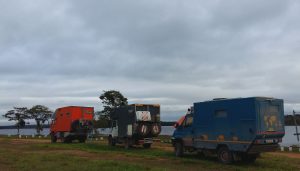
Cuthbert making friends with the French trucks
Meanwhile… back to the Jesuit Missions… the first one is in San Javier and we are suitably impressed. Both the original design and the sympathetic restoration work are stunning. There is fine attention to detail and the museums detailing the restoration process are as interesting as the Missions themselves. Here in San Javier we bumped into some French travellers that we had previously met back in March in Bariloche, Argentina and we all parked up together for the night by a lake.
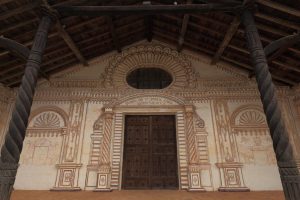 The next Mission was in Concepción where we were once again impressed with the work, followed by another Mission 150km down the road in San Ignacio. Each Mission is a real treasure; it’s just sad that they are all so remote and difficult for more people to visit. The whole Circuit is a few hundred kilometres long and stretches towards the Brazilian border, so we hop-off half-way around for a detour into Brazil to visit The Pantanal. We’ll be back to Bolivia to complete the Mission Circuit… sometime!
The next Mission was in Concepción where we were once again impressed with the work, followed by another Mission 150km down the road in San Ignacio. Each Mission is a real treasure; it’s just sad that they are all so remote and difficult for more people to visit. The whole Circuit is a few hundred kilometres long and stretches towards the Brazilian border, so we hop-off half-way around for a detour into Brazil to visit The Pantanal. We’ll be back to Bolivia to complete the Mission Circuit… sometime!

Mug-shot
Beef, anyone?
It is as we sit in the Mission town of San Ignacio that we realise we have a teeny ‘problema’ with our forthcoming border crossing to Brazil. Regular readers… do you recall our previous whinging about the problems of travelling with food into Chile? Well… we have just learned that Brazil’s food import restrictions are much more draconian: basically… nothing is allowed. Regardless of packaging – fresh, processed, tinned, dried, frozen, whatever! We have received confirmation from a few reliable sources: because all the border routes in this area are currently subject to heavy anti-drug-running measures, the customs checks are extremely thorough and rigorously enforced. With very few exceptions, pretty much all food will be confiscated. OMG, OMG, OMG!!! We have loads (and we mean loads) of food! We always keep a couple of weeks’ stock in case we get stuck anywhere, but we have also recently done a major re-stock and have even more food than we would usually carry! Particularly beef. We have a freezer full of beef. Oh, and cheese. Quite a lot of that too. Plus we have the ‘emergency’ canned/dried foods and the store cupboard of many herbs, spices, packets, sauces etc. If they take it all from us, it will cost us a small fortune to replace. Some of it is irreplaceable here, it would be so disappointing to lose our store of treats brought from UK. WTF to do???
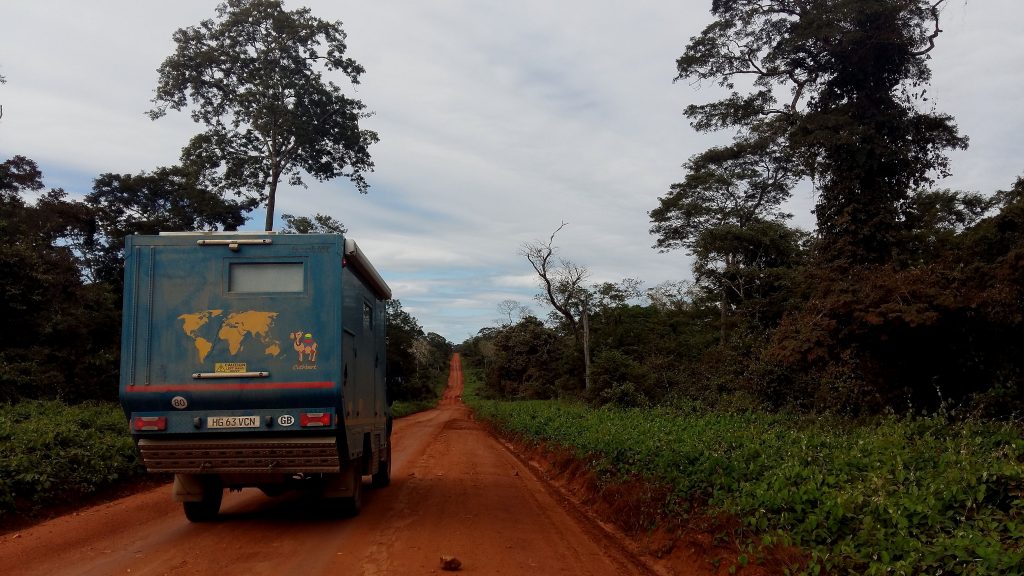
300km track to Brazil, with no food!
We start by eating lots of beef! Roasting joints, frying steaks, making chilli with mince… lunch and supper each day… beef! After four days we never want to see another piece of red meat 🙂 We also wonder what to do with our small mountain of non-perishable food. We decide to pack it all in a large kit-bag and find somewhere to leave it. We will be returning to complete Bolivia’s Jesuit Mission Circuit after we have seen Brazil’s Pantanal, so we are chuffed when the one top-notch hotel in San Ignacio agrees to take our large kit-bag of food into their secure left-luggage room. Result!!! As we drive out of San Ignacio, Cuthbert is lighter by the weight of a small heffalump, and we’re not sure where our next meal is coming from!
Not far down the 300+ km rough-road to Brazil, we’re well into lowland jungle-zone now and we see the anti-drug-running enforcement in full-swing. The route is highly policed; there are heavily armed military foot-patrols and fixed road blocks stopping us regularly for checks. They are courteous and only doing their job so we have no problem with this, but we are now glad that we found a temporary home for our food.
Bye Bolivia…
So far it has been a quick two-week skip across central Bolivia from west to east. We’ve seen an interesting cross-section of the country, but we can’t really say yet that we have fallen in love with the place. The people are pleasant enough and we’ve had no bad-natured encounters, but we haven’t found it to be a warmly welcoming country. Nevertheless, if we’re honest, we haven’t really given Bolivia a fair crack of the whip yet. Final judgment is therefore suspended and we look forward to the return visit 🙂
Link to next blog: A Bit of Brazil Link to full South America Blog
Beginning Bolivia Gallery
- Jesuit Missions Bolivia
- Cochabamba
- Inca? Or pre-Inca?

